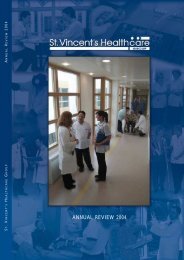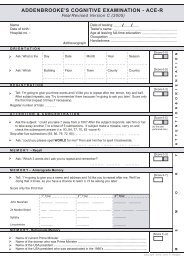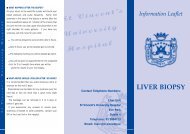ANNUAL REVIEW master Final3a - St Vincent's University Hospital
ANNUAL REVIEW master Final3a - St Vincent's University Hospital
ANNUAL REVIEW master Final3a - St Vincent's University Hospital
You also want an ePaper? Increase the reach of your titles
YUMPU automatically turns print PDFs into web optimized ePapers that Google loves.
<strong>St</strong>. Vincent’s Healthcare Group Limited - Annual Review 2007<br />
Education & Research<br />
Vitamin D is thought to mediate its immunomodulatory effects via the induction of tolerogenic dendritic<br />
cells and regulatory T cells. IL-10 is also thought to play an important role in mediating the effects of<br />
Vitamin D3. CD39, a recently described marker that identifies a subset of Treg, converts ATP to<br />
adenosine, thereby mediating suppressive effects.<br />
We plan to use CD39 as a marker of functional Treg and to correlate %CD39 expressing Treg with<br />
vitamin D levels and other clinical parameters.<br />
We will also measure the concentrations of IL-10 and other cytokines in the serum and correlate these<br />
with Vitamin D levels.<br />
d) To determine any genetic differences between people with MS in the Northwest and the South of<br />
Ireland, and to compare with controls.<br />
HLA DRB1*1501 typing and examination of vitamin D receptor (VDR) polymorphisms, which have<br />
been associated with MS.<br />
Genetic susceptibility to MS is implicated on the basis of classical family and monozygotic twin studies.<br />
However the concordance rate in identical twins is only 25 to 30%, despite sharing 100% of DNA and<br />
family environment. MS does not follow a particular pattern of inheritance and is probably a<br />
multifactorial, polygenic disorder.<br />
Several reviews have discussed linkage and association studies of the well known multiple sclerosis<br />
candidate genes, the MHC, and specifically the HLA located at chromosome 6 (6p21), have long been<br />
known to be associated with MS but exact location of the locus within the HLA complex is still largely<br />
presumptive. In Northern European, and Ireland, carriage of DRB1*1501and the DQB2*0602 haplotype<br />
of the HLA class 11 molecule is associated with increased MS risk.<br />
Until recent association of IL2RA and IL7RA gene SNPs with MS, no definite links beyond MHC on<br />
chromosome 6 had been established. However, this explains only a small proportion (less than 0.2%)<br />
of the variance in the risk of the development of multiple sclerosis. As previously mentioned, vitamin D<br />
receptor gene polymorphisms may also play a role in development of MS. It is likely that susceptibility<br />
to MS probably consists of many risk alleles, each contributing a modest effect to overall risk.<br />
e) To assess the needs of people with MS in Dublin, Wexford and Donegal<br />
In collaboration with Dr. Malachi Mc Kenna, Consultant Endocrinologist; Dr. Barbara Murray, Principal<br />
Biochemist; Dr. Jennifer Brady, Senior Biochemist, Metabolism Laboratory, SVUH; Dr. M.O’Brien, PhD<br />
Genetics; Dr. J. Fletcher, Immunology, TCD; Dr. C. Dunne, IBTS; Dr. P. Fitzpatrick, UCD School of Public<br />
Health /Pop. Science; Dr. Howard Johnson, National Population Health Directorate, HSE, Dr <strong>St</strong>eevens<br />
<strong>Hospital</strong>; Dr. Peter Doran, CRC; MS Society<br />
4. Oligoadenylate synthetase (OAS) in Multiple Sclerosis: not just a haplotype association.<br />
MS is an autoimmune disease characterised by unregulated inflammation and subsequent<br />
neurodegeneration. Type 1 Interferon (IFN) therapy is effective in some, but not all, patients. Type 1<br />
interferons (endogenous and exogenous) exert anti-inflammatory effects by upregulating a number of<br />
proteins, including those of the OAS family. A number of single-nucleotide polymorphisms (SNPs) of the<br />
OAS 1 gene have been identified. A single nucleotide polymorphism (SNP) at exon 7 in the OAS 1 gene<br />
influences OAS enzyme activity. Allele ‘G’ at exon 7 is associated with highest, and Allele ‘A’ lowest, OAS<br />
activity.<br />
Return to Contents<br />
44
















